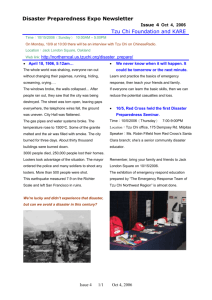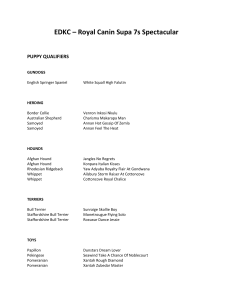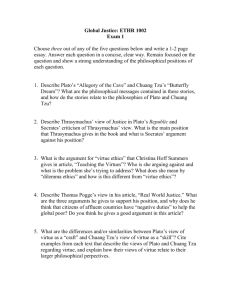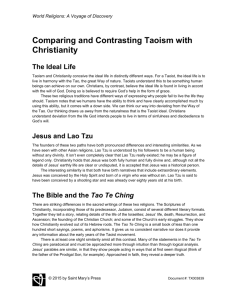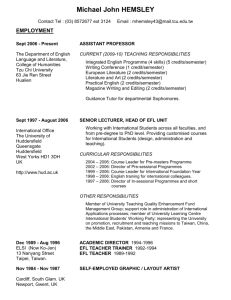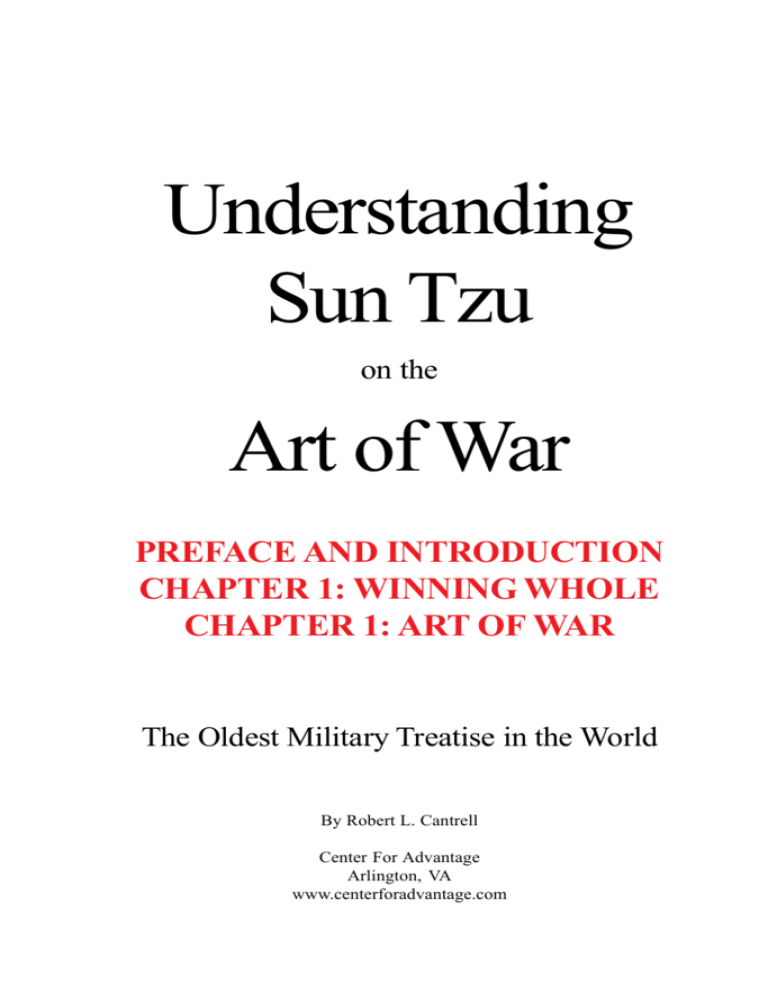
Understanding
Sun Tzu
on the
Art of War
PREFACE AND INTRODUCTION
CHAPTER 1: WINNING WHOLE
CHAPTER 1: ART OF WAR
The Oldest Military Treatise in the World
By Robert L. Cantrell
Center For Advantage
Arlington, VA
www.centerforadvantage.com
UNDERSTANDING SUN TZU ON THE ART OF WAR
Center For Advantage
P.O. Box 42049
Arlington, VA 22204
Copyright © 2003 by Robert L. Cantrell
Published by Center For Advantage
www.centerforadvantage.com
All rights reserved. No part of this book may be reproduced in any form or
by any means, electronic or mechanical, including photocopying, recording,
or by any information storage and retrieval system, without permission in
writing from the publisher.
Printed in the United States of America
First Printing 2003
Library of Congress Control Number: 2002093398
ISBN 0-9722914-0-7
Attention Corporations, Educational Institutions, and Professional
Organizations: This book is available at quantity discounts for educational
and gift purposes. For information please contact - Center For Advantage,
P.O. Box 42049, Arlington, VA 22204; info@centerforadvantage.com.
Contents
Preface
Introduction
1Six Principles
of Sun Tzu
2 - Winning Whole
3 - Leading to Advantage
4 - Deception
5 - Energy
6 - Strength & Weaknesses
Initiative
Observations of Sun Tzu’s Principles Outside the Military
The Six Sun Tzu Principles as One
Conclusion
i
2
9
10
19
29
38
45
54
60
68
72
- on the Art of War
Sun
I Tzu
II - Laying Plans
III - Waging War
IV - Attack by Stratagem
V - Tactical Dispositions
VI - Energy
VII - Weak Points and Strong
VIII - Maneuvering
IX - Variation on Tactics
X - The Army on the March
XI - Terrain
XII - The Nine Situations
XIII - Attack by Fire
The Use of Spies
75
76
79
82
85
87
90
94
98
100
104
108
114
117
About the Author
About Center For Advantage
Acknowledgements
120
121
122
UNDERSTANDING SUN TZU ON THE ART OF WAR
Dedicated to the soldiers
PREFACE
Preface
2,500 years ago a Chinese warrior and philosopher named Sun Tzu
became a grand master of strategy and captured the essence of his philosophies
in a book called, by English speaking nations, Sun Tzu on the Art of War. To
this day, military strategists around the world have used Sun Tzu’s
philosophies to win wars and have made Sun Tzu on the Art of War a staple
of their military education.
Those seeking to understand strategy in business, law, and life have also
turned to Sun Tzu on the Art of War for the wisdom therein. For at the heart
of Sun Tzu’s philosophies are strategies for effective and efficient conflict
resolution useful to all who wish to gain advantages over their opposition.
To read Sun Tzu on the Art of War is not to immediately understand it,
however. Readers often find the text difficult to work with and Sun Tzu’s
philosophies counterintuitive to their day-to-day reality. This causes a
dilemma for those who wish to teach and study Sun Tzu’s philosophies. To
simplify Sun Tzu’s philosophies risks losing the subtlety of thought necessary
to master Sun Tzu on the Art of War. To keep the subtlety risks losing the
most basic insights to the complexity of the text.
Capturing the subtlety of Sun Tzu’s philosophies in an understandable
form is where Understanding Sun Tzu on the Art of War comes in. In this
book, the author uses his many years of practical experience with Sun Tzu’s
i
ii
UNDERSTANDING SUN TZU ON THE ART OF WAR
philosophies to clarify them without simplifying them. He does so by
examining contemporary battlefields within the context of Sun Tzu’s
philosophies and by examining Sun Tzu’s own Taoist philosophical sources,
sources that have been heard in popular Western culture through voices
such as Yoda’s in the Star Wars movies. A lot goes on between the lines in
Sun Tzu on the Art of War, and that gives the book its power.
Author’s notes:
1.
2.
3.
4.
The second half of this book contains a complete edited version of
the original Lionel Giles translation of Sun Tzu on the Art of War
that Luzac and Co. published in London and Shanghai in 1910.
This edited version was designed to make the text clearer for modern
readers than the dated original. Giles’s translation, regardless, is
still considered one of the best English translations available. Those
with a more scholarly interest in Sun Tzu may also wish to read a
copy of the Lionel Giles translation in its original form for which a
number of sources exist both electronically and in hard copy.
This book uses masculine pronouns throughout the text. Such
references pertain to both genders as applicable to a situation.
Any references that involve the commitment of bodily harm are
intended to illustrate Sun Tzu on the Art of War for its originally
intended purpose, war. Such illustrations are meant for use literally
only by those government-sanctioned professionals authorized to
undertake such activities as Sun Tzu described them, for example,
military soldiers in the conduct of their duties. Those in other
professions should take such references figuratively.
Excerpts from the Tao Te Ching are edited versions of a translation
written by James Legge and published by Humphrey Milford in
London in 1891. This editing is designed to make the text clearer
for present day readers than the dated original.
Notes on the cover:
1.
2.
The cover art shows a spearhead that was hand forged in the ways
characteristic of those used to create weapons throughout Asia and
Europe in the pre-industrial ages.
The Chinese characters used on the cover appear on the original
Lionel Giles publication of Sun Tzu on the Art of War from 1910.
They translate literally to “Sun Tzu on military ways.”
Sun Tzu said:
The art of war is of vital importance to
the State. It is a matter of life and death,
a road to safety or to ruin. Therefore, it
is a subject that must be thoroughly
studied.
2
UNDERSTANDING SUN TZU ON THE ART OF WAR
Introduction
Picture the rapids of a great river. See its waters rush over and around
giant boulders. Close your eyes and listen to its roar. Then feel its relentless
power when it crashes over a precipice. Now picture that you remove a cup
of water anywhere along this river and sense how that water loses its power
and starts to dry up in the sun. Then empty the cup back into the river, and
know that as a part of the whole river, that water wears rocks into sand and
does not dry up. So a soldier and philosopher observing a river from its
banks in this fashion might hypothesize that a great army kept whole can
conquer nations and still stay whole, but an army divided or too small will
face peril and death. Any review he might make of successful military
campaigns in the past and in his present would confirm his hypothesis.
Like a river on its journey to the sea, he could therefore conclude that the
way of fighting involves fighting as a unified whole, an entire army acting
as one, with one objective in mind, and with its own preservation as an army
also kept in mind.
This philosopher records his idea in writing on the bamboo strips of his
time. Later, readers of his work see that his idea rings true regardless of
their profession. A powerful and universal principle comes to light called
the principle of winning whole, meaning winning with your resources and
your objective intact. It represents the first of six universal principles
described by Sun Tzu that, when used together as one, present the most
powerful strategic method yet recorded in any profession for winning
conflicts.
INTRODUCTION
In this book, you have an invitation to take a journey that will uncover the
heart of Sun Tzu’s strategic method and how to apply it. This journey could
change how you approach the many challenges you will face throughout the
rest of your life. You will read about a martial art of the mind, a way to
outthink and outfight those who oppose your needs and desires. Ideally, you
will also gain an appreciation of the many ways opponents may direct force
against you so you can position yourself accordingly to preclude harm.
THREE STEPS BACK
On this journey, we will take three steps back from the present day to
review Sun Tzu’s original work and representations of Sun Tzu’s own source
material. This material includes:
1. The philosophies of Sun Tzu on the Art of War as they apply
to war.
2. Taoist philosophies, described best by the Chinese
philosopher Lao Tzu in the Tao Te Ching, that form the
apparent root of Sun Tzu’s own philosophies and a core of
traditional Chinese philosophical thought.
3. The Ways of life, drawn from the natural world, that form
the apparent root of the Taoist philosophies described by
both Lao Tzu and Sun Tzu.
We will use this material to uncover the meaning behind and the practical
application of all six Sun Tzu principles that include:
1.
2.
3.
4.
5.
6.
Winning Whole - How to succeed with your resources and
your objective intact
Leading to Advantage - How to prepare and position your
soldiers for victory
Deception - How to keep your intentions secret from
opponents
Energy - How to apply force effectively and efficiently
Strengths and Weaknesses - How to find the best path to
the goal
Initiative - How to take and keep the advantage in a conflict
Our journey will conclude by combining these six principles into a
powerful and unified philosophy that affords the means to plan, act, and
succeed with the effectiveness and efficiency of one of Sun Tzu’s own students.
In so doing, we will discuss how Sun Tzu’s strategic method applies to any
profession, with illustrations drawn from business, law, medicine, sports,
and personal relations. Enter first, however, into the world of the soldier
that Sun Tzu knew.
3
4
UNDERSTANDING SUN TZU ON THE ART OF WAR
THE SOLDIER
The soldier is the army and the army is the soldier. He wins by outthinking
and outfighting his opponent with the best tools at his disposal. A thousand
years ago, horses and armor, swords, shields, and lances represented the
best tools for fighting at anyone’s disposal. With them, men clashed in
battle, outthought and outfought each other as individuals and as armies,
and decided the fates of many great cultures.
Fast forward to the present day and these tools of war have long passed
into history, replaced by weapons faster, more precise, and infinitely more
destructive. Still, history can surprise us with the resiliency of the old.
America’s first major battle of the 21st century featured high tech Special
Forces soldiers riding horses into battle with their Afghan allies much like
the days of old – albeit supported by pilots in the likes of F-16s and F-18s
instead of archers.
Regardless of the time or the place, the warrior within a man stays the
same. He learns strategies that follow the principles of the ages. And no
one, East or West, has better captured the essence of strategy then did Sun
Tzu – 2,500 years ago.
DISSEMINATION
2,500 years ago, Sun Tzu’s recorded words on military strategy proved
so insightful that the Chinese nobility preserved them intact, and they, and
many others who have read them to this day, would put those ideas to work.
Translations of Sun Tzu’s text spread throughout Asia. The ideas became a
staple of Japanese military philosophy as firm as China’s own and no doubt
influenced battle plans to include the surprise attack on Pearl Harbor in
1941. A reading of Quotations From Chairman Mao Tse-Tung also reveals
many direct paraphrases from Sun Tzu that Chinese, North Korean, and
Vietnamese forces used militarily against the West and each other throughout
the second half of the twentieth century. No doubt all these nations will
continue to use Sun Tzu’s ideas to gain military, political, and economic
advantages appropriate to their national interests in the present day.
The use of Sun Tzu’s philosophies in the West has a shorter and sketchier
history. Some military historians suggest that Napoleon applied Sun Tzu’s
philosophies in his military planning and even carried a copy of Sun Tzu’s
book with him on his campaigns. He certainly could have had in his
possession a French translation available in his time, and his methods of
maneuver show a marked similarity to those described by Sun Tzu.
Historians also debate where and when the first deliberate application of
Sun Tzu’s philosophies by an English speaking commander took place. It
may have been on the battlefields of Arabia in 1917. Here, T. E. Lawrence,
INTRODUCTION
a British officer leading an Arab army in a revolt against the Turkish army,
used methods of maneuver warfare for which there is little doubt that Sun
Tzu at least would have approved. Like Sun Tzu, Lawrence’s use of maneuver
warfare has been studied by military students the world over, and his actions
serve to illustrate principles of effective warfare Sun Tzu described.
T. E. LAWRENCE
At the height of World War I, the Turkish army occupied the port city of
Akaba on the Sinai Peninsula. This occupation posed a threat to British
control of the Suez Canal further to the west.
At first glance, Akaba seemed invulnerable to British attack. From the
sea, the British navy faced huge guns the Turkish army had installed on the
cliffs that overlooked the city. These guns could sink any ship that dared
sail too close. Behind Akaba, the British Army faced an expansive desert,
considered uncrossable because of its punishing heat and absence of water.
Upon further reflection on Akaba, Lawrence apparently decided that
Turkish commanders had allowed the strength of their position to also become
its weakness. Since the Turkish army expected no threat from the desert, all
their large guns faced the sea and could not be turned around. So in the
summer of 1917, T. E. Lawrence led a contingent of men across the
uncrossable desert. This contingent of men formed the core of an Arab
army that attacked and captured Akaba from the desert side instead of the
sea. Lawrence’s attack surprised and defeated the Turkish garrison at Akaba.
The great guns that only faced the sea proved useless to the Turkish defense.
In the aftermath, most of the Turkish garrison was captured instead of killed.
Lawrence’s Arab army suffered few casualties of its own. Akaba itself
remained intact.
In 1910, seven years before Lawrence’s attack on Akaba, Dr. Lionel Giles,
a staff member of the Department of Oriental Printed Books and Manuscripts
at the British Museum in London, introduced the English-speaking world
to an effective translation of Sun Tzu’s writings. Lionel Giles published his
translation through Luzac and Co. in London and Shanghai under the title,
Sun Tzu on the Art of War. Lawrence, an avid reader with a keen interest in
military strategy, had a seven-year span in which to discover and study Sun
Tzu on the Art of War before his own military endeavors began.
Though we can at best only hypothesize that Lawrence studied Sun Tzu
on the Art of War, we do know his method of attack on Akaba exemplified
Sun Tzu philosophies: Lawrence attacked his enemy’s weaknesses and won
the battle whole. If Lawrence did in fact study Sun Tzu on the Art of War,
then he fell into a minority. Though available since 1910, the study of Sun
Tzu on the Art of War did not gain prominence in English speaking militaries
until Vietnamese military leaders, to include Gen. Vo Nguyan Giap, used
5
6
UNDERSTANDING SUN TZU ON THE ART OF WAR
principles characteristic of Sun Tzu to defeat American forces in Vietnam in
the 1960s and 1970s. Gen. Giap, known to have studied T. E. Lawrence and
his military methods, was also known to have studied Sun Tzu.
PRESENT DAY USE
The study of Sun Tzu on the Art of War became an American military
education staple after the Vietnam War. As a case in point, the U.S. Marine
Corps book of strategy, Warfighting, builds upon ideas about maneuver
warfare taken directly from Sun Tzu on the Art of War. Recently, business
and law schools worldwide added Sun Tzu on the Art of War to their course
of study. Why? The use of a weapon of the mind – which Sun Tzu on the Art
of War fundamentally is – does not require the physical manifestation of the
sword.
To read Sun Tzu’s words, however, is not to immediately understand
them. That would be equivalent to picking up a sword for the first time and
expecting to fight well with it. To understand Sun Tzu’s words means to put
them into practice within the context of the Taoist philosophies from which
he wrote them. These Taoist philosophies formed the cornerstone of
philosophical thought for Sun Tzu’s audience. They fill in the detail between
the lines of Sun Tzu’s own words. Sun Tzu described a lot more in his book
than meets the eye. We will therefore take the next step of our exploration
into China where history tells us an enlightened philosopher named Lao
Tzu wrote a book called the Tao Te Ching.
THE TAO TE CHING AS A REPRESENTATION OF SUN TZU’S
PHILISOPHICAL SOURCE
Tao Te Ching means “the Way of life.” The philosophies described within
the Tao Te Ching provide the foundation of the Taoist religion and the Taoist
philosophy prominent in China during Sun Tzu’s time. These philosophies
continue to have such worldwide appeal today that only the Christian Bible
is printed in a wider variety of languages.
Like Sun Tzu on the Art of War, scholars estimate the Tao Te Ching to be
about 2,500 years old. Though a short book of only 81 verses, the Tao Te
Ching influences Eastern views of the world similarly to the way the Bible
influences Western worldviews. Most Western people, for example, regardless
of their personal religious affiliations, understand the meaning behind the
biblical philosophy, “turn the other cheek.” Within these four simple words,
you can communicate an important idea about conflict resolution that scholars
have written about for centuries.
Philosophies from the Tao Te Ching similarly imbed themselves into
Eastern culture. “Water seeks its own level,” for example, communicates
the inherent and often permanent good and bad of a person’s nature, an idea
INTRODUCTION
much larger than the apparent sum of its five words. The phrase “the journey
of a thousand miles begins with a single step,” commonly used in both the
East and West, is also from the Tao Te Ching. It communicates the humble
origins of even the greatest endeavors. By using such understood ideas as
his foundation, Sun Tzu succeeded in packing a lot of information into a
very small text, particularly for those who have a foundation in Taoist ideas.
RECONCILING THE TAO TE CHING WITH WAR
Like the Bible, the Tao Te Ching acknowledges that a state’s leadership
cannot always avoid war. Lao Tzu therefore believed a military triumph
should be treated as a funeral simply because war proved necessary at all.
Sun Tzu, like any soldier trying to reconcile his religion with war, would
have grappled with Lao Tzu’s words against war. Lao Tzu said:
Arms, however beautiful, are instruments
of ill omen, hateful to all creatures.
Those who know the way of life do not
wish to employ them.
The superior man prefers his higher
nature, but in time of war, will call upon
his lower nature.
Weapons are an instrument of ill omen,
and not the instruments of the superior
man, until he has no choice but to employ
them.
Peace is what he prizes; victory through
forces of arms is to him undesirable.
To consider armed victory desirable
would be to delight in killing men, and
he who delights in killing men will not
prevail on the world.
To celebrate when man’s higher nature
comes forth is the prized position; when
his lower nature comes forth is time for
mourning.
The commander’s second has his place
in man’s higher nature; the commanding
general has his place assigned to man’s
lower nature; his place assigned to him
as if to a funeral.
He who has killed multitudes of men
should weep for them; and the victor in
battle has his place accorded as in a
funeral.
7
8
UNDERSTANDING SUN TZU ON THE ART OF WAR
So you also have from Sun Tzu, in his third chapter, a philosophy that
can reconcile the way to fight a war with the Way of life. Sun Tzu said:
In the practice of the art of war, it is best
to take the enemy’s country whole and
intact. To shatter and destroy his country
is inferior to this way. So, too, it is better
to capture an army intact than to destroy
it, better to capture a regiment, a
detachment or a company intact than to
destroy them. Hence to fight and win in
all your battles is not the foremost
excellence; to break the enemy’s
resistance without fighting is the
foremost excellence.
Throughout Sun Tzu on the Art of War, Sun Tzu advocated winning
without actual fighting. The pursuit of that ideal, though not always possible,
allows a warrior to reconcile military service with the Tao Te Ching. It also
served a very practical purpose for Sun Tzu and his followers. In a world
that contained many warring states, a victor who depleted his own resources
to destroy an enemy could expect a third state to take advantage of his
weakened condition. To win wars yet stay strong was essential to survival
in China 2,500 years ago. Winning wars and staying strong carries equal
importance today. And so we will begin our effort to understand Sun Tzu by
exploring the first of six core principles discussed in this book – the principle
of winning whole.
9
Six Principles of
Sun Tzu
10
UNDERSTANDING SUN TZU ON THE ART OF WAR
1 - Winning Whole
To win whole means to win with your resources and your objective intact.
Any other result means you have at least partly failed at your mission. When
you fight, you fight for something of value, and should you destroy yourself
or that something of value while fighting to obtain it, then you have lost
your real purpose for fighting.
The list below serves as a guide for winning whole. This chapter and the
chapters that follow will develop this list.
How to Win Whole
1.
2.
3.
4.
Remove your enemy’s hope for victory
Use all your advantages
Exploit your enemy’s weaknesses
Attack along an unexpected line
If you deny your enemy any hope for victory, you diminish his will to
fight, and defeating him will prove easier than otherwise. If you use all your
advantages, you leave nothing on the table that might prevent undue loss.
By attacking your enemy’s weaknesses, the energy you must spend to succeed
decreases. When you attack along an unexpected line, you can apply force
against your enemy where he has not prepared for you. All these measures
WINNING WHOLE
enhance your probability of winning with your resources intact and your
objective intact. The Cold War, fought by the United States and its allies
against the Soviet Union and its allies, illustrates these points.
THE COLD WAR
From 1945 to 1990, the United States and its allies fought a Cold War
against the Soviet Union and its allies. This war threatened to become the
most devastating Hot War imaginable.
The United States and its allies won the Cold War with little bloodshed,
particularly when compared to the preceding global conflict, World War II.
The United States and its allies maintained a sufficiently strong conventional
military force to deter Soviet aggression and supplemented that force with
nuclear weapons. The victors indirectly won the Cold War economically.
The Soviet Union collapsed on itself without a direct military attack by the
United States or its allies. Economies under Soviet-style communism could
not afford to pay for the enormous militaries arrayed against the West. Bottom
line: the Cold War ended and the world stayed whole.
THE AMERICAN CIVIL WAR
In contrast, America’s Civil War of 1861-1865, though it succeeded in
holding the union of American states together, demonstrated a progression
into all the war-fighting methods Sun Tzu said to avoid. Sun Tzu said:
Thus the highest form of generalship is
to defeat the enemy’s plans;
In 1861, Abraham Lincoln, the newly elected President of the United
States, could not find a way to peacefully defeat the secessionist plans of
Jefferson Davis, the President of the Confederate States of America. When
Confederate forces shelled Fort Sumter in Charleston Harbor, they sealed
Lincoln’s failure.
...the next best is to keep the enemy’s
forces divided;
From 1861 through 1863, Lincoln attempted to divide the Confederacy
by taking control of the Mississippi River. At the same time, he made no
fewer than three attempts to march on the Confederate Capital in Richmond,
Virginia. Lincoln failed in part because Confederate officers, like Gen. Robert
E. Lee, outclassed their Union counterparts on the battlefield.
...the next best is to attack the enemy’s
army in the field;
11
12
UNDERSTANDING SUN TZU ON THE ART OF WAR
In 1864, Lincoln assigned Gen. Ulysses S. Grant, a general who had
earlier succeeded in capturing the key control city on the Mississippi,
Vicksburg, to target Lee’s Army of Northern Virginia itself instead of
Richmond. Grant sent Gen. William T. Sherman down through the west to
continue with the plan to divide the Confederacy. To Gen. George G. Meade
of the Army of the Potomac, who Grant sent to destroy Lee’s army in Virginia,
Grant commanded: “Wherever Lee goes, there you will go also.”
...and the worst policy is to besiege
walled cities.
After a bloody series of battles that failed to destroy Lee’s army, Grant
laid siege to Lee’s army in the fortified city of Petersburg from the summer
of 1864 to the spring of 1865. His need to lay siege meant adding 10 months
to an effort that was taking some 200,000 casualties to whittle Lee’s army
from 60,000 soldiers at the beginning of 1864 to fewer than 10,000 by its
surrender in 1865. Sherman’s advances in the meantime destroyed vital
Confederate cities south of Richmond and Petersburg, plus much of the
region’s railways and infrastructure. Though the war reunited the nation,
the south arguably required more than one hundred years to recover from
the method.
THE WAY OF LIFE
The American Civil War ended with America intact but with the south in
ruin. It became a precursor of total wars to come that would see the
devastation of fighting escalate sharply. World War I became the devastation
of armies, and World War II became a total devastation of great cities and
populations as well. Militarily, the great nations of Europe, both the winners
and the losers, became a shadow of their former selves on the world stage
and so relinquished the title of world superpowers to the United States and
the Soviet Union. Errors on both sides – Allied weakness that allowed Axis
forces to conquer Europe and the Asian Pacific with little loss to themselves,
and Axis miscalculations regarding their ability to hold their gains for the
long term – resulted in more death and destruction by war than the world
has yet seen. This final result was not in accord with the Way of life and
therefore not in accord with the principles of Sun Tzu.
But what exactly is this “Way of life?” Men have pondered this question
for years. George Lucas borrowed the idea of the Way for a Western audience
when he created the philosophies of Yoda in the Star Wars movies. On the
Way, which Lucas called “the Force,” Yoda said:
Size does not matter. Look at me. Judge
me by my size do you? And where you
should not. For my ally is the Force,
WINNING WHOLE
and a powerful ally it is. Life creates it,
makes it grow. Its energy surrounds us
and binds us....
The Way, as attributed to Taoist philosophy, does not allow its masters to
move stones with their mind like Lucas’s Jedi Warriors, but it does purport
to describe an energy that binds all things. Life, which energy sustains and
destroys, creates conflict. The Way of conflict in the natural world sustains
growth in the whole system. Predator and prey live in balance with each
other to the benefit of the whole system. Winning whole also ascribes to the
Way of life because you succeed at resolving conflicts productively and
without destroying yourself and the objective. Fighting in accord with the
Way of life, when you cannot avoid fighting, allows you to win whole with
your army and your objective intact because you take measures, which we
will discuss, that ensure this result. On the Way, in the Tao Te Ching, Lao
Tzu said:
Before Heaven and Earth, there was
something undefined yet complete,
formless, alone, constant, everywhere
and untiring, the mother of all things.
I know not its name so I name it “the
Way of life.” I should prevail to call it
great, for it is in constant flow, becoming
remote yet returning in a circle.
Therefore the Way is great; Heaven is
great; Earth is great; and a wise man is
also great.
In the universe, these are the four great
things.
Man takes his law from the Earth; the
Earth takes its law from Heaven; Heaven
takes its law from the Way; the law of
the Way being what it is.
A proper assessment of a situation is a critical part of Sun Tzu’s overall
philosophy that ensures an army engages in battles it can win. Engaging in
battles you cannot win is a waste of time and resources and not in accord
with the Way of life. In the first chapter of Sun Tzu on the Art of War,
therefore, Sun Tzu described five constant factors a military leader must
assess to afford a view of the whole situation before a battle. These constant
factors correspond to the four great things of the universe we just read from
the Tao Te Ching. The first constant factor corresponds to the Way of life.
The second corresponds to heaven. The third corresponds to earth. The
fourth and fifth correspond to man. Sun Tzu said:
13
14
UNDERSTANDING SUN TZU ON THE ART OF WAR
Five constant factors govern the art of
war, to be assessed when determining the
conditions in the field. These constant
factors are: 1) The Way 2) Heaven 3)
Earth 4) The Commander 5) Method
and discipline.
The Way, which Lionel Giles translated into English as “Moral Law” for
Western readers, proves the most important assessment of Sun Tzu’s five
constant factors prior to a military conflict and also the assessment easiest
to miscalculate or ignore. The Way – Moral Law – determines whether one
army can defeat another army without completely destroying it. Sun Tzu
said:
Moral law causes people to be in
complete accord with their ruler and to
follow him regardless of any danger to
their lives.
The people of England had the moral law during the Battle of Britain in
World War II where Winston Churchill said:
Let us therefore brace ourselves to our
duties, and so bear ourselves that if the
British Empire and Commonwealth last
for a thousand years, men will still say,
this was their finest hour.
An army prepared to defend its beloved homeland from capture, or an
army cornered and fighting for its life, when compared to an army fighting
without due cause, will find its soldiers’ commitment to a fight more in line
with the Way of life. Such an army may prove impossible to defeat in battle
short of total annihilation.
An army imbued with the moral law is simply more willing to fight on
and fight to the death than one without the moral law. To defeat an enemy
with high morale while staying whole means to kill him, capture him, or
break his morale; before soldiers meet in combat. Leave him hope and you
invite disaster upon yourself. Winston Churchill said of the challenge that
faced his enemies:
We shall fight on the beaches. We shall
fight on the landing grounds. We shall
fight in the fields and in the streets. We
shall fight in the hills. We shall never
surrender!
WINNING WHOLE
MORALE
Morale has four conditions that determine whether you or an enemy
will fight or will quit. A key objective when fighting is to keep your
morale high and your enemy’s morale low. Of course, your enemy will
seek the same against you.
Four Conditions of Morale
1.
2.
3.
4.
The soldier fights – Because he has hope
The soldier quits – Because he can quit
instead of fighting and still live
The soldier fights – Because he has no
choice but to fight or die
The soldier quits – Because he loses his will
to fight
To foster high morale, keep in mind that soldiers fight because they have
hope or because they have no choice but to fight or die. Also note that both
of these reasons to fight can transcend a soldier’s own self to include the
hope or desperation of other people or an ideal, or both. This ability to
transcend self allows a soldier to fight to his own death to save others when
he might otherwise have surrendered and saved himself.
On the other side of morale, soldiers quit because quitting seems a better
option than fighting, even if quitting means certain death. This too can
transcend a soldier’s own self if fighting for other people or an ideal loses its
purpose.
To win whole, you find the means to keep your morale high and the
morale of your charges high while you destroy your enemy’s morale and
make it easy for him to quit or impossible to escape destruction. You and
any other military leader must also desire that your soldiers fight for the
hope of some betterment to themselves or those for whom they care, but Sun
Tzu knew a commander might have to leverage the hand of peril to succeed
at the critical moment of battle. For this, he advocated that a commander
leave no route for his own soldiers to return, and, therefore, no easy way for
his own troops to quit. Sun Tzu said:
On the day they are ordered out to battle,
your soldiers may weep, those sitting up
crying into their garments, and those
lying down letting the tears run down
their cheeks. But let them once be in a
15
16
UNDERSTANDING SUN TZU ON THE ART OF WAR
situation where they cannot take refuge,
and they will display the courage of a
Chu or a Kuei.
At the heart of this statement may lay the resolve shown by Allied soldiers
that landed on the Normandy beaches on D-Day on June 6, 1944. To get off
the beach, they had no where else to go but forward. Allied commanders
surely knew the implications of that fact before the attack began.
On the other side of morale again, history presents many cases where
opposing commanders have made it difficult for their opposition to quit and
have not destroyed their opposition’s will to fight to compensate for this.
Their policies served to put enemy soldiers in a place where they could not
take refuge with the result that they fought harder than they might have
otherwise. Russian soldiers, for example, would not surrender to the German
SS during World War II. Surrender meant their certain execution, while
fighting, no matter how desperate, at least afforded them a chance to live.
In turn, the Russians would not take German SS soldiers as prisoners. Both
sides suffered high casualties and high levels of brutality as a result. At a
time when many Russians initially viewed German invaders as liberators
over an oppressive Stalinist regime, military theorists must consider how
World War II might have turned out if German forces had acted as liberators
instead of proving an even greater evil.
In contrast, making it easy for an enemy to quit has helped America
reduce casualties in most of its battles, particularly when by other means
America had destroyed its opponents’ will to fight. Take note of the mass
Iraqi surrender during the Gulf War in 1991, after those Iraqi units had been
subjected to the relentless American bombing campaign on their positions.
Prisoners of the American military often received – and still receive – better
treatment than what they received from their own armies. The underlying
idea provides another way to win whole that Sun Tzu acknowledged when
he said:
When you surround an army, leave an
outlet free. Do not press a desperate foe
too hard.
A desperate foe will fight back when you would prefer that he surrender.
The general idea carries over into other aspects of life as well. It is a reason,
for example, to find a way to “save face” in Asia so that an opponent can
accept a loss without further conflict or disgrace.
WINNING WHOLE
MORALE TRAP
Of course high morale alone does not win wars when it leads to
overconfidence. You may remember this excerpt from a certain famous
poem by Alfred Lord Tennyson.
Half a league, half a league,
Half a league onward,
All in the valley of Death
Rode the six hundred.
“Forward, the Light Brigade!
Charge for the guns!” he said:
Into the valley of Death
Rode the six hundred.
You could argue that the soldiers of the British Light Brigade, about
whom Alfred Lord Tennyson wrote these lines in 1870, had plenty of morale
to stand on when the Cossacks and the Russians cut them down. Over 600
cavalry soldiers under Maj. Gen. the Earl of Cardigan followed orders to
charge heavily defended Russian artillery positions over a mile distant from
their starting point. The bravery displayed by these soldiers inspired
Tennyson whose poem made them famous the world over. But despite the
fame, Tennyson’s poem describes a military fiasco. Perhaps 200 of those
who set out on the charge returned alive with nothing to show for their
effort. The Light Brigade never had a chance to succeed.
High morale, perhaps, and almost certainly overconfidence on the part
of the commander, affected the two hundred and sixty troops belonging to
U.S. Lt. Col. George Armstrong Custer when they fought Sioux, Cheyenne,
and Arapaho warriors to the death at Little Bighorn on June 25, 1876. A
commander must bear in mind certain other practical issues aside from morale
before engaging in battle.
Consider Custer’s defeat in context with Sun Tzu’s other four assessments.
Though heaven likely did not favor either Custer’s cavalry or the Native
American warriors in June of 1876, the conditions of earth would normally
have favored the mobility of Custer’s cavalry since the Native American
warriors had also to protect their families and Custer’s cavalrymen were not
so encumbered. However, Custer’s arrival in Montana, ahead of a supporting
brigade-sized force, and Custer’s subsequent decision to engage Native
American warriors before the rest of that force arrived, gave Native American
warriors an advantage of earth at a decisive point in time.
We do not know whether Custer underrated the Sioux Chief Sitting Bull’s
ability as a commander or underrated the method and discipline of his
warriors. We do have evidence Custer discounted reports from his scouts
17
18
UNDERSTANDING SUN TZU ON THE ART OF WAR
that indicated Sitting Bull had assembled a large warrior force, a total that
would number more than 2,000. This evidence is supported further by
Custer’s decision to proceed deeper into the valley which led to the hill
where he fought his last stand despite losing contact with two flanking
elements of his force.
In the end, the results of the battle show Custer had miscalculated the
threat facing his men. Only one of Custer’s troop, a horse named Comanche,
survived when the Battle of Little Bighorn ended – though thirty men from
one of his flanking detachments, not directly involved in Custer’s fight, did
return from the field. The final outcome for Custer proved the polar opposite
of Sun Tzu’s principle to win whole.
To avoid the morale trap, therefore, you must ensure you are not operating
in accord with one of three conditions shown below. Think about this closely.
The propensity to deceive ourselves on these matters is a major and
unfortunate part of the human condition.
The Morale Trap
1.
2.
3.
You believe you have hope when there is
no hope
You believe you fight to the death when
you have other acceptable options
You allow pride to override good
judgment
If you believe you have hope when you do not, you may take ill adventures
where you should not. If you believe you fight or die when you do not really
face such dire conditions, you may needlessly continue a fight for no gain.
If you allow pride to override your good judgment, you may fight even when
you know you should not, regardless of the consequences.
With the above in mind, Custer’s failure at the Battle of Little Bighorn
prompts us to examine the second of the six Sun Tzu principles we will
explore, leading to advantage. If you can avoid the morale trap, leading to
advantage becomes a key part of winning whole.
Next Chapter: Leading to Advantage
75
Sun Tzu
on the
Art of War
Translated by Lionel Giles in 1910
Edited Version by Robert Cantrell in 2003
76
UNDERSTANDING SUN TZU ON THE ART OF WAR
I - Laying Plans
1. Sun Tzu said: The art of war is of vital importance to the State.
2. It is a matter of life and death, a road to safety or to ruin. Therefore, it is
a subject that must be thoroughly studied.
3. Five constant factors govern the art of war, to be assessed when determining
the conditions in the field.
4. These constant factors are:
(1)
(2)
(3)
(4)
(5)
The Moral Law
Heaven
Earth
The Commander
Method and discipline
5, 6. The Moral Law causes people to be in complete accord with their ruler
and to follow him regardless of any danger to their lives.
7. Heaven signifies night and day, cold and heat, times and seasons.
LAYING PLANS
8. Earth comprises near and far distances; dangerous and secure positions;
open ground and narrow passes; the chances of life and death.
9. The Commander stands for virtues of wisdom, sincerity, benevolence,
courage and strictness.
10. Method and discipline describes the disposition of the army, its
subdivisions, the gradation and deployments of its officers, the maintenance
of roads that carry supplies to the army, and the management of military
expenditure.
11. These five constant factors should be familiar to every general. He who
knows them will be victorious; he who does not know them will fail.
12. Therefore, when making your assessment to determine which of two
sides has the advantage, ask:
13. (1) Which of the two sovereigns commands the Moral law?
(2)
Which of the two generals has the most ability?
(3)
To whom lie the advantages derived from Heaven and Earth?
(4)
On which side is discipline most rigorously enforced?
(5)
Which army is stronger?
(6)
Which side has the most highly trained officers and men?
(7)
Which army serves rewards and punishments most consistently?
14. By means of these assessments I can forecast victory or defeat.
15. The general that heeds my counsel and makes these assessments
will achieve victory. Let this general be retained in command! The
general that does not heed my counsel and makes few assessments
will suffer defeat. Let this general be dismissed!
16. While heeding the merit of my counsel, avail yourself also to any helpful
circumstances that give you advantages beyond the ordinary conditions.
17. When such favorable circumstances arise, modify your plans accordingly.
18. All warfare is based on deception.
19. Hence, when able to attack, seem as if unable to attack; when using
forces actively, seem inactive; when nearby, make the enemy believe you are
far away; when far away, make the enemy believe you are nearby.
20. Hold out baits to entice the enemy to act. Feign disorder, and strike him
when he seeks to take advantage.
77
78
UNDERSTANDING SUN TZU ON THE ART OF WAR
21. If your enemy is secure at all points, prepare for his attack. If he has
superior strength, evade him.
22. If your enemy bares a short temper, seek to irritate him. Pretend to be
weak, so he becomes arrogant.
23. If your enemy takes his ease, give him no rest. If his forces unite, separate
them.
24. Attack your enemy where he is unprepared, appear where he does not
expect you.
25. These military deceptions that bring victory must not be revealed as
deceptions before they succeed.
26. Now the general who wins a battle makes many calculations in his
headquarters before he fights a battle. The general who loses a battle makes
but few calculations beforehand. Thus do many calculations lead to victory
and few calculations to defeat. What need be said of no calculation at all? It
is by observing the points of these calculations that I can foresee who is
likely to win or lose in battle.
12 Chapters Follow


